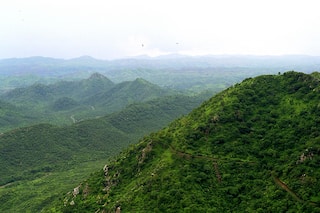Giant Arthropods Dominated The Seas 470 Million Years Ago, Fossil Site In Morocco Reveals
Giant, 'free-swimming' arthropods dominated the seas 470 million years ago, a newly discovered fossil site in Morocco has revealed. The site at Taichoute was once an undersea, but is now a desert.

Giant, 'free-swimming' arthropods dominated the seas 470 million years ago, a newly discovered fossil site in Morocco has revealed. The site at Taichoute, Morocco was once an undersea, but is now a desert. According to an international team of researchers, the site and its fossil record are very different from other previously described and studied Fezouata Shale sites from 80 kilometres away.
What is Fezouata Biota?
The Fezouata Biota in Morocco is a unique Early Ordovician fossil assemblage, the discovery of which revolutionised the understanding of Earth's early animal diversifications. The Ordovician period is a geological era which occurred about 485.4 million to 443.8 million years ago. Shale is a geological rock formation rich in clay, typically derived from fine sediments, and has been buried in fairly quiet environments at the bottom of seas or lakes, for over millions of years.
The study describing the findings was recently published in the journal Scientific Reports.
Taichoute, which is considered to be a part of the wider "Fezouata Biota", opens new avenues for palaeontological and ecological researchers, according to the authors.
In a statement released by University of Exeter, Dr Farid Saleh, the lead author on the paper, said everything about the new locality at Taichoute is new, including its sedimentology, palaeontology and the preservation of fossils. He added that these findings further highlight the importance of the Fezouata Biota in completing researchers' understanding of past life on Earth.
Dr Xiaoya Ma, one of the authors on the paper, said while the giant arthropods discovered at Taichoute have not yet fully been identified, some may belong to previously described species of the Fezouata Biota, and some will certainly be new species.
She added that the arthropods' large size and free-swimming lifestyle suggest they played a unique role in those ecosystems.
Important findings
Due to the importance of the Fezouata Shale in understanding the evolution during the Early Ordovician period, about 470 million years ago, it was recently selected as one of the 100 most important geological sites worldwide.
The Fezouata Shale fossils are important for palaeontologists and archaeologists because these sediments allow them to investigate the anatomy of early animal life on Earth. The reason behind this is that the fossils discovered in the rocks of the Fezouata Biota include mineralised elements such as shells, and have exceptionally preserved soft parts such as internal organs.
According to the university, animals of the Fezouata Shale, located in Morocco's Zagora region, lived in a shallow sea. Since the sea experienced repeated storm and wave activities, the animal communities were buried and preserved in place as exceptional fossils.
Free swimming or nektonic animals remain a relatively minor component overall in the Fezouata Biota, the statement said.
More about the arthropod fossils discovered
The Taichoute fossils discovered during the study are preserved in sediments that are a few million years younger than those from the Zagora area. Also, the sediments are dominated by fragments of giant arthropods.
Professor Allison Daley from the University of Lausanne, and one of the authors on the paper, said animals such as brachiopods (marine invertebrates that have hard valves on the upper and lower surfaces) are found attached to some arthropod fragments. This indicates that the large carapaces (hard upper shell of an organism) acted as nutrient stores for the community dwelling on the seafloor, once the brachiopods were dead and lying on the seafloor.
Some of the interesting fossils discovered include a non-mineralised arthropod belonging to the extinct group called Marrellomorpha, which included organisms lacking mineralised hard parts; a palaeoscolecid (group of extinct worms) worm, and a trilobite (extinct marine arthropod).
Dr Bertrand Lefebvre from the University of Lyon, and a senior author on the paper, concluded that the Fezouata Biota keeps surprising researchers with new unexpected discoveries.







































